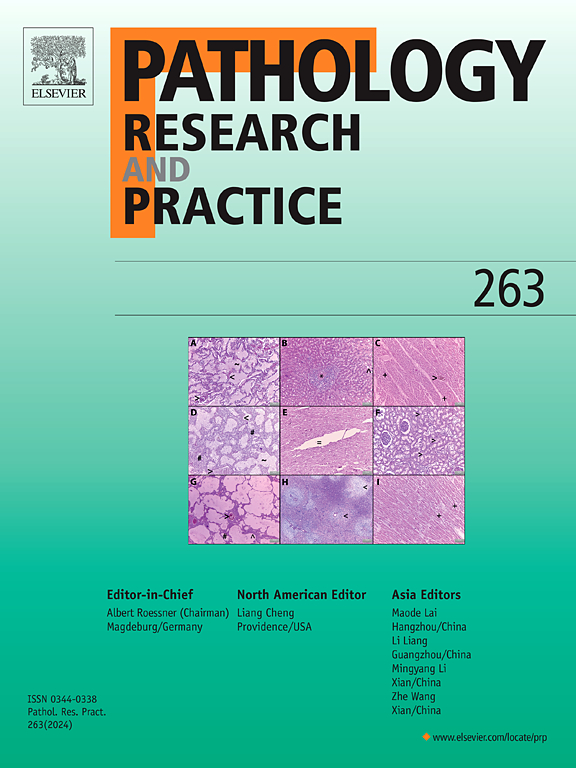LncRNA CRNDE and HOTAIR: Molecules behind the scenes in the progression of gastrointestinal cancers through regulating microRNAs
IF 2.9
4区 医学
Q2 PATHOLOGY
引用次数: 0
Abstract
Gastrointestinal (GI) cancers, such as gastric cancer, hepatocellular carcinoma, colorectal cancer, and esophageal cancer, pose a significant medical and economic burden globally, accounting for the majority of new cancer cases and deaths each year. A lack of knowledge about the molecular mechanisms of GI cancers is reflected in the low efficacy of treatment for individuals with late stage and recurring illness. Understanding the molecular pathways that promote the growth of GI cancers may open doors for their therapy. Numerous long non-coding RNAs (lncRNAs) that are produced differently in normal and malignant tissues have been discovered by genome-wide techniques. The role of lncRNAs in the diagnosis, proliferation, metastasis, and drug resistance of different GI cancers has been investigated in recent research. LncRNAs may affect transcription, epigenetic modifications, protein/RNA stability, translation, and post-translational modifications via their interactions with DNA, RNAs, and proteins. Also, by functioning as competing endogenous RNAs (ceRNAs), they control the synthesis of certain microRNAs (miRNAs), which in turn modify the downstream target molecules of these miRNAs. Based on recent studies, lncRNAs in particular, CRNDE and HOTAIR, sponge different miRNAs and their downstream genes, which in turn regulate GI cancers development, including cell proliferation, invasion, migration, and chemoresistance. In this comprehensive review, we present an overview of the biological roles of CRNDE and HOTAIR and their associated mechanisms, miRNAs/mRNA pathways, in various GI cancers, encompassing colorectal cancer, hepatocellular carcinoma, esophageal cancer, and gastric cancer.
LncRNA、CRNDE和HOTAIR:通过调节microrna在胃肠道癌症进展中的幕后分子。
胃肠道(GI)癌症,如胃癌、肝细胞癌、结直肠癌和食道癌,在全球范围内造成了重大的医疗和经济负担,占每年新发癌症病例和死亡人数的大部分。对胃肠道肿瘤分子机制的缺乏反映在对晚期和复发性疾病个体的低疗效治疗中。了解促进消化道肿瘤生长的分子途径可能为其治疗打开大门。通过全基因组技术已经发现了许多在正常和恶性组织中产生不同的长链非编码rna (lncRNAs)。近年来,lncrna在不同胃肠道肿瘤的诊断、增殖、转移和耐药中的作用已被研究。LncRNAs可能通过与DNA、RNA和蛋白质的相互作用影响转录、表观遗传修饰、蛋白质/RNA稳定性、翻译和翻译后修饰。此外,通过竞争内源性rna (ceRNAs)的功能,它们控制某些microRNAs (miRNAs)的合成,进而修饰这些miRNAs的下游靶分子。近年来的研究表明,lncrna,尤其是CRNDE和HOTAIR,能够吸收不同的mirna及其下游基因,进而调控胃肠道肿瘤的发展,包括细胞增殖、侵袭、迁移和化疗耐药。在这篇全面的综述中,我们概述了CRNDE和HOTAIR的生物学作用及其相关机制、miRNAs/mRNA通路在各种胃肠道癌症中的作用,包括结直肠癌、肝细胞癌、食管癌和胃癌。
本文章由计算机程序翻译,如有差异,请以英文原文为准。
求助全文
约1分钟内获得全文
求助全文
来源期刊
CiteScore
5.00
自引率
3.60%
发文量
405
审稿时长
24 days
期刊介绍:
Pathology, Research and Practice provides accessible coverage of the most recent developments across the entire field of pathology: Reviews focus on recent progress in pathology, while Comments look at interesting current problems and at hypotheses for future developments in pathology. Original Papers present novel findings on all aspects of general, anatomic and molecular pathology. Rapid Communications inform readers on preliminary findings that may be relevant for further studies and need to be communicated quickly. Teaching Cases look at new aspects or special diagnostic problems of diseases and at case reports relevant for the pathologist''s practice.

 求助内容:
求助内容: 应助结果提醒方式:
应助结果提醒方式:


